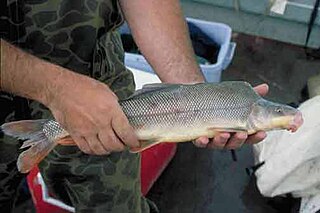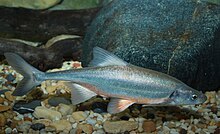
The Gila trout is a species of salmonid, related to the rainbow trout, native to the Southwest United States. Prior to 2006 the Gila trout was federally listed as endangered. In July 2006, after much work by the Game and Fish departments in New Mexico and Arizona, the US Forest Service and the US Fish and Wildlife Service, the Gila trout was down-listed to threatened, with a special provision called a "4d rule" that will allow limited sport fishing – for the first time in nearly half a century. By the time the Gila trout was closed to fishing in the 1950s, its numbers and range were so depleted and so reduced this copper-colored trout simply wasn't very accessible to anglers. As of 2011 there is fishing in both states for this fish.

Ouray National Wildlife Refuge is a wildlife refuge in central Uintah County, Utah in the northeastern part of the state. It is part of the National Wildlife Refuge system, located two miles northeast of the village of Ouray, 10 miles (16 km) southeast of the town of Randlett, and 30 miles (50 km) southwest of Vernal.

Gila is a genus of fish belonging to the family Cyprinidae, native to the United States and Mexico. Species of Gila are collectively referred to as western chubs. The chiselmouth is a close relative, as are members of the genus Siphateles. Several members of the genus are endangered or extinct due to loss of habitat caused by diversion or overuse of water resources, particularly in the western United States.

The roundtail chub is a cyprinid fish in the genus Gila, of southwestern North America. It is native to the Colorado River drainage basin, including the Gila River and other tributaries, and in several other rivers. It is part of the "robusta complex", which includes the Gila robusta robusta, G.r. grahami, and G.r. seminuda.

The razorback sucker is a suckerfish found in rivers and lakes in the southwestern United States and formerly northwestern Mexico. It can grow to 91 cm (3 ft) in length and is recognisable by the keel between its head and dorsal fin. It used to inhabit much of the Colorado River Basin but commercial fishing, river damming, and habitat loss have caused great declines in populations. It is now restricted to the Colorado River upstream of the Grand Canyon and to four reservoirs, Lake Mead, Lake Mohave, Lake Havasu, and Lake Powell.

The woundfin is a species of minnow endemic to the Virgin River of the southwestern United States. It is the only species in the monotypic genus Plagopterus.
The Upper Colorado River Endangered Fish Recovery Program is a multi-agency partnership to recover endangered fish in the upper Colorado River basin while water development proceeds in compliance with state and federal law.

The humpback chub is a federally protected fish that lived originally in fast waters of the Colorado River system in the United States. This species takes its name from the prominent hump between the head and dorsal fin, which is thought to direct the flow of water over the body and help maintain body position in the swift currents of the Colorado river. The body is almost entirely scaleless, retaining only about 80 mid-lateral scales along the lateral line. The fish is very streamlined, with a thin caudal peduncle and a deeply forked tail. The back is a light olive gray, the sides silver, and the belly white. The dorsal fin usually has nine rays, and the anal fin 10 or more. Maximum recorded length is 38 cm.
The Colorado pikeminnow is the largest cyprinid fish of North America and one of the largest in the world, with reports of individuals up to 6 ft (1.8 m) long and weighing over 100 pounds (45 kg). Native to the Colorado River Basin of the southwestern United States and adjacent Mexico, it was formerly an important food fish for both Native Americans and European settlers. Once abundant and widespread in the basin, its numbers have declined to the point where it has been extirpated from the Mexican part of its range and was listed as endangered in the US part in 1967, a fate shared by the three other large Colorado Basin endemic fish species: bonytail chub, humpback chub, and razorback sucker. The Colorado pikeminnow is currently listed as vulnerable by the IUCN, while its NatureServe conservation status is "critically imperiled".
The Southwestern Native Aquatic Resources and Recovery Center, formerly known as Dexter National Fish Hatchery & Technology Center, is a U.S. Fish and Wildlife Service facility dedicated to fish culture techniques for threatened and endangered fishes of the American Southwest. Located in Dexter, New Mexico, it is the only federal facility in the nation dedicated to studying and holding only threatened and endangered fish. Scientists at the Dexter facility perform life history studies and carefully analyze fish genetics while maintaining a refuge for 16 imperiled fish species. Dexter National Fish Hatchery was established in 1931, to satisfy demands for game fish throughout the Southwest. New laws brought changes to the hatchery in the 1970s.
The Mora National Fish Hatchery and Technology Center is one of seven federal fish hatchery technology centers in the United States. Located in Mora County, New Mexico, on State Route 434, it is mainly involved in the restoration and recovery of the threatened Gila trout, a fish found only in the upper headwaters of the Gila River in New Mexico and Arizona. Formal cooperative agreements between the U.S. Fish and Wildlife Service and New Mexico Game and Fish call for the Mora hatchery to also establish a brood stock of Rio Grande cutthroat trout and provide fish culture training to other biologists. The Mora hatchery also works to conserve the bonytail chub. The hatchery accepts a limited number of volunteers to assist in conservation activities.

The Sonora chub is a species of ray-finned fish in the family Cyprinidae. It is found in Mexico and the United States.

The Gila chub is a species of ray-finned fish in the family Cyprinidae. It is found in Mexico and the United States. The Gila chub is closely related to the roundtail chub. This species is commonly found in association with the Gila topminnow, the desert and Sonora sucker, and the longfin and speckled dace.

The Yaqui chub is a species of freshwater fish in the family Cyprinidae. It is found in northern Mexico and the United States. The Yaqui chub is a medium-sized minnow fish that historically occurred in streams of Rios Matape, Sonora, and the Yaqui systems of Sonora, Mexico. It is one of the five species of the genus Gila in Arizona. The Yaqui chub is closely related to G. ditaenia, and G. orcutti ; and shares several physical characteristics with the G. orcutti, but proves different by having a black wedge near the base of the caudal fin.
Willow Beach is located on the Arizona side of the Colorado River between Lake Mead and Lake Mohave. Both lakes are part of the Lake Mead National Recreation Area administered by the U.S. National Park Service.

The headwater chub is a species of fish in the family Cyprinidae. It is found in Arizona and New Mexico.
The Virgin chub or the Virgin River chub is a medium-sized, silvery minnow, generally less than 15 cm (5.9 in) long and reaching lengths of 25 cm (9.8 in). The back, breast, and part of the belly are embedded with small scales, naked in some individuals. The length of the head divided by the depth of the caudal peduncle typically results in a ratio of 4.0 to 5.0. The scales are typically lacking basal radii or are with extremely faint lines.

Catostomus latipinnis is a North American fish identified by its enlarged lower lips. It belongs to the genus Catostomus, commonly known as suckers. Historically, the flannelmouth sucker ranged in the Colorado River Basin, including parts of Wyoming, Utah, Colorado, New Mexico, Nevada, California, and Arizona; however, this species has been entirely extirpated from the Gila River Basin in Arizona.

The Owens tui chub was described in 1973 as a subspecies of tui chub endemic to the Owens River Basin in Eastern California, United States. The Owens tui chub is distinguished from its closest relative, the Lahontan tui chub, by scales with a weakly developed or absent basal shield, 13 to 29 lateral and apical radii, also by the structure of its pharyngeal arches, the number of anal fin rays, 10 to 14 gill rakers, and 52 to 58 lateral line scales. Dorsal and lateral coloration varies from bronze to dusky green, grading to silver or white on the belly. It may reach a total length of 30 centimetres (12 in). Owens tui chub are believed to be derived from Lahontan Basin tui chub that entered the Owens Basin from the north during the Pleistocene Epoch.














